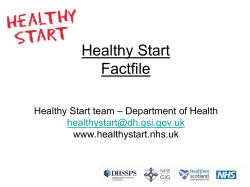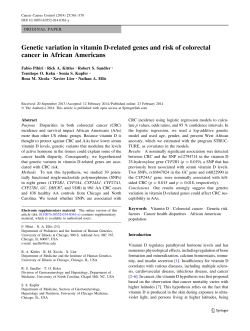
Now Available! The Ddrops Family of products
Vitamin D What a mother should know • Studies of women in the northern US have shown a high percentage of vitamin D deficiency in women during pregnancy - and in their newborn infants.10 • When a mother has low vitamin D blood levels, her breast milk contains low levels of vitamin D. • The American Academy of Pediatrics recommends a vitamin D supplement from birth onwards.1 The Canadian Paediatric Society recommends that pregnant women recieve 2000 IU of vitamin D daily. Remember... • Always read and follow instructions on label. • Consult with your healthcare provider to discuss an individual approach with dietary supplements. Ddrops® is available for adults in a format that provides 1000 IU per drop. Now Available! The Ddrops Family of products Canada’s #1 Selling infant vitamin 13 ® Award-winning Ddrops® products were created as a better way for parents to give their families the vitamin D they need, in just one drop! • Baby Ddrops® 400 IU - specifically designed for breast-fed babies. A mother only needs to put a single drop of Baby Ddrops® on her nipple, where baby takes it in along with the milk. • Kids Ddrops® 400 IU - is a simple, safe, and fun way for toddlers and children to receive 400 IU of vitamin D. Just one purified drop of Kids Ddrops® contains 400 IU of vitamin D3, without any other chemicals or additives. • Ddrops® Booster 600 IU - is a new dose of 600 IU /drop that matches the recent Institute of Medicine (IOM) & Health Canada Recommended Dietary Allowance (RDA) for children over 1 year to the age of 70.1 • Ddrops® 1000 IU - makes it easy to take naturally sourced vitamin D3 without pills and without additives. Each purified drop contains 1000 IU of vitamin D3 and permits effective absorption and easy dose adjustments according to individual needs. • Vegan Ddrops® 1000 IU - provides 1000 IU vitamin D2 – a purified plant source of vitamin D developed for those individuals following Vegan diets. Always read and follow the label. Adequate Vitamin D levels are associated with the normal development and maintenance of healthy bones and teeth. Bones and teeth need important minerals like calcium and phosphorus, and vitamin D helps growing bones absorb these minerals. With more research and interest in vitamin D, experts are looking to understand the function of vitamin D in other areas of the body. Vitamin D is now considered a factor in the maintenance of good health.3,4 A recent study published by the American Academy of Pediatrics (AAP)5 suggests that most American babies are not receiving the recommended daily amount of vitamin D. The AAP says parents should be encouraged to give an oral vitamin D supplement to babies who are either breast-fed or consuming less than approximately 1 quart of infant formula daily.1 1. Wagner CL et al. Prevention of rickets and vitamin D deficiency in infants, children and adolescents. Pediatrics 2008; 122: 1142-1152. 2. Institute of Medicine. Dietary Reference Intakes for Calcium and Vitamin D. November 2010. http//www.iom.edu/Reports/2010/Dietary-References-Intakes-for-Calcium-and-VitaminD.aspx 3. Institute of Medicine 2006. Otten JJ, Pitzi Hellwig J, Meyers LD, editors. Dietary Reference Intakes: The Essential Guide to Nutrient Requirements http://www.nap.edu/catalog/11537.html 4. Health Canada, Drugs and Health Products, Natural Health Products Ingredients Database, Monograph vitamin D. 2007 http//webprod.hc-sc.gc.ca/nhpid-bdipsn/monoReq.do?id=183&lang=eng54. Perrine CG et al. Adherence to vitamin D recommendations amung US infants. Pediatrics 2010; 125: 627-632. 5. Perrine CG et al. Adherence to vitamin D recommendations among US infants. Pediatrics 2010; 125:627-632. 6. Health Canada > Natural Health Products > Licensed Natural Health Products Database. NPN 00762881 D-Vi-Sol Drops - List of Non-Medical Ingredients 7. Mead Johnson Nutrition (Canada) Co., http://www.enfamil.ca/en/products/vitamins1_faq.html - website archive May 2007 8. American Academy of Dermatology. Academy Issues Updated Position Statement on Vitamin D. January 19, 2011. www.aad.org/media/background/news/Releases/American_Academy_Issues_Updated_Postion_Statement/ 9. Centers for Disease Control and Prevention (CDC). Vitamin D Expert Panel Meeting October 11-12, 2001 Atlanta, Georgia. Final Report. http://www.cdc.gov/nccdphp/dnpa/butrition/pdf/Vitamin_D_Expert_Panel_Meeting.pdf 10. Merewood A, et al. Widespread Vitamin D Deficiency in Urban Masachusetts Newbrns and Their Mothers. Pediatics 2010; 124; 640. 11. Wagner CL et al. Vitamin D supplementation durring pregnancy. www.aap.org/advocay/release/PAS2010/pregnant.htm 12. Wagner CL. Vitamin D: Recommendations during Pregnancy, Lactation and Early Infancy Clinical Lactation, 2011, Vl.2(1), 27-31 13. AC Nielson Aug 2011 TM ©2012 Ddrops Company. All Rights Reserved. Ddrops is a registered trademark of Ddrops Company. Patent no. 2578881. The Mom’s Choice Awards Honoring Excellence logo is a trademark of the Mom’s Choice Awards. The Parent Tested Parent Approved logo is a trademark of the Parent Tested Parent Approved. 8033.00 Just the vitamin D your baby needs Sunshine vitamin D pure and simple Why your baby needs vitamin D Vitamin D is essential to a baby’s health and growth - and is particularily necessary for the proper development of bones. Recommended for: Recommended vitamin D3 intake*: Tolerable upper intake levels2: • Canadian Paediatric Society1 • Health Canada2 • American Academy of Pediatrics3 Breast-fed infants 400 IU 1000 IU (0-6 months) Canadian Paediatric Society1 Breast-fed infants in Canada’s north (above 55˚N latititude) 800 IU American Academy of Pediatrics3 Partially breast-fed infants and formula fed infants who are ingesting <1000mL of fortified formula/day 400 IU • Health Canada2 • Institute of Medicine4 Children 1 to 3 years old 600 IU Vitamin D is Recommended by: • • • 1500 IU (6-12 months) NA Why more mothers are choosing Baby Ddrops Water-based vitamin D products 1 International Unit (IU) of vitamin D = 0.025 micrograms. Each drop of Baby Ddrops® and Kids Ddrops® contains 400 IUs of vitamin D3. Each drop of Ddrops® Booster contains 600 IUs of vitamin D3. Baby Ddrops® Contains vitamin D, water, artificial flavours, colouring and a surfactant (polysorbate - a synthetic chemical) to keep vitamin D in solution6,7 Baby Ddrops® contains only vitamin D in a type of fat that is naturally present in breast milk, with no artificial flavours or preservatives. Taken from the bottle with an eye dropper, each full ‘squeeze’ gives roughly 1 mL Patented Eurodropper provides exactly 400 IU of vitamin D3 per daily drop Begins to oxidize once opened, and must be discarded after 50 days6 Baby Ddrops® is stable, has a long shelf-life and does not require refrigeration Approximately 50 daily doses per bottle Baby Ddrops® comes in a 90 dose bottle NA 2500 IU Easy to use − Easy to take ® Baby Ddrops Vitamin D Pure and Simple. ® • No need for an eyedropper or spoon, there’s no muss, fuss or guess-work with Baby Ddrops®.. • Baby Ddrops® has no taste and no odour. • Baby Ddrops® is wheat-free, soya-free and gluten-free. Once a day, just before a bottle or breast-feeding, a mother puts a single drop of Baby Ddrops® onto the nipple, a clean finger or a pacifier - and allows baby to suck for half a minute. Baby Ddrops® comes in a patented Eurdropper bottle. Simply turn the bottle upside down and allow the drop to come out. Each drop contains 400 IU of vitamin D. Sunlight is the main source of vitamin D. Direct exposure of infants to sunlight is not recommended - and the Canadian Dermatology Association and Health Canada advise against direct exposure of infants to sunlight.8 Babies given vitamin D grow up to be healthier adults.9
© Copyright 2025





















